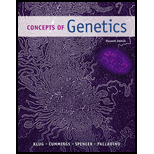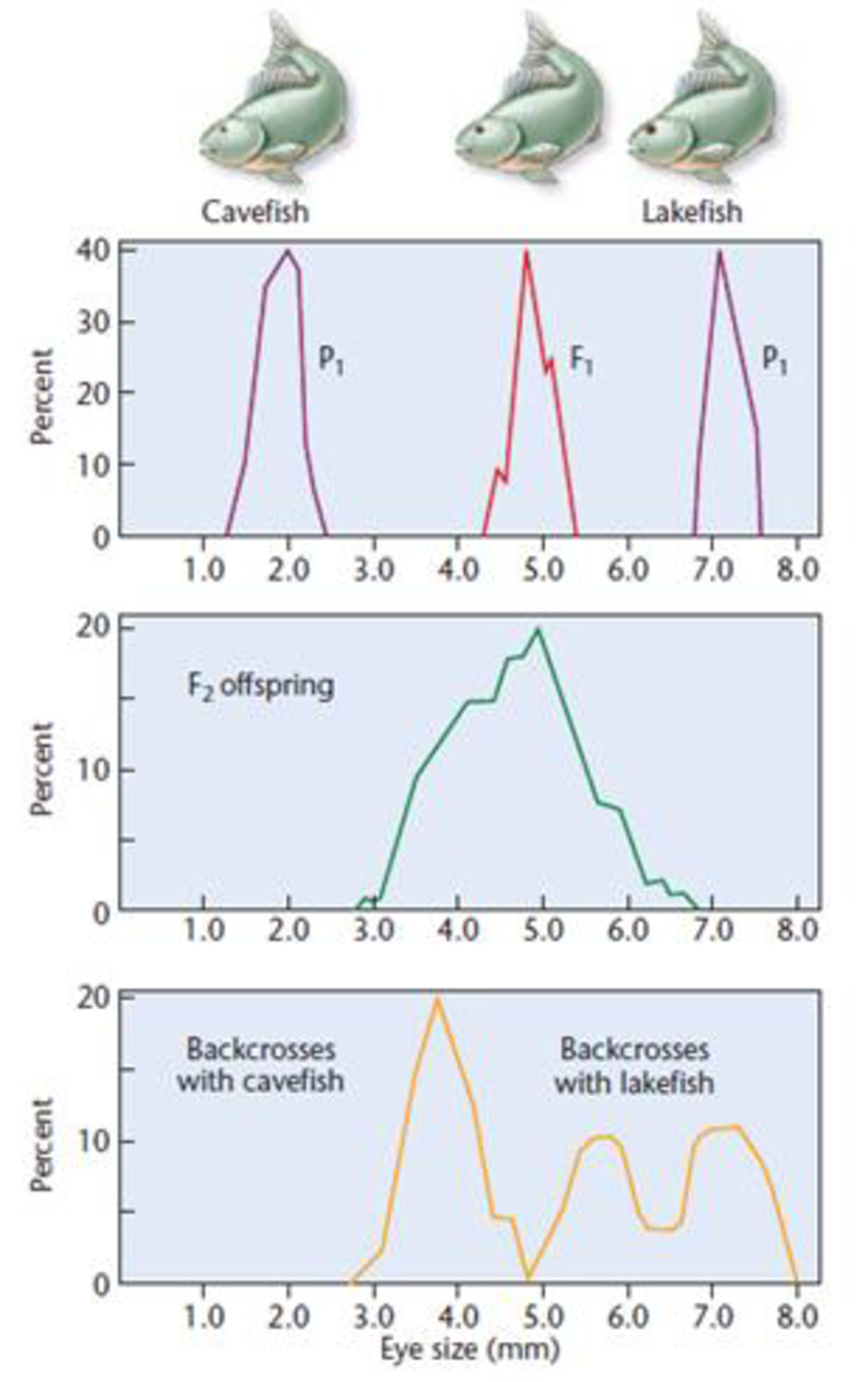
Concepts of Genetics (11th Edition)
11th Edition
ISBN: 9780321948915
Author: William S. Klug, Michael R. Cummings, Charlotte A. Spencer, Michael A. Palladino
Publisher: PEARSON
expand_more
expand_more
format_list_bulleted
Textbook Question
Chapter 23, Problem 29ESP
In 1988, Horst Wilkens investigated blind cavefish, comparing them with members of a sibling species with normal vision that are found in a lake [Wilkens, H. (1988). Evol. Biol. 25:271–367]. We will call them cavefish and lakefish. Wilkens found that cavefish eyes are about seven times smaller than lakefish eyes. F1 hybrids have eyes of intermediate size. These data, as well as the F1 × F1 cross and those from backcrosses (F1 × cavefish and F1 × lakefish), are depicted below. Examine Wilkens’s results and respond to the following questions:
- (a) Based strictly on the F1 and F2 results of Wilkens’s initial crosses, what possible explanation concerning the inheritance of eye size seems most feasible?
- (b) Based on the results of the F1 backcross with cavefish, is your explanation supported? Explain.
- (c) Based on the results of the F1 backcross with lakefish, is your explanation supported? Explain.
- (d) Wilkens examined about 1000 F2 progeny and estimated that 6–7 genes are involved in determining eye size. Is the
sample size adequate to justify this conclusion? Propose an experimental protocol to test the hypothesis. - (e) A comparison of the embryonic eye in cavefish and lakefish revealed that both reach approximately 4 mm in diameter. However, lakefish eyes continue to grow, while cavefish eye size is greatly reduced. Speculate on the role of the genes involved in this problem.

Expert Solution & Answer
Want to see the full answer?
Check out a sample textbook solution
Students have asked these similar questions
Explain in a small summary how:
What genetic information can be obtained from a Punnet square? What genetic information cannot be determined from a Punnet square?
Why might a Punnet Square be beneficial to understanding genetics/inheritance?
In a small summary write down:
Not part of a graded assignment, from a past midterm
Chapter 23 Solutions
Concepts of Genetics (11th Edition)
Ch. 23 - A homozygous plant with 20-cm-diameter flowers is...Ch. 23 - The following table shows measurements for fiber...Ch. 23 - The following cable gives the percentage of twin...Ch. 23 - Prob. 1CSCh. 23 - Prob. 2CSCh. 23 - Prob. 3CSCh. 23 - HOW DO WE KNOW? In this chapter, we focused on a...Ch. 23 - CONCEPT QUESTION Review the Chapter Concepts list...Ch. 23 - Define the following: (a) polygenic, (b) additive...Ch. 23 - A dark-red strain and a white strain of wheat are...
Ch. 23 - Height in humans depends on the additive action of...Ch. 23 - An inbred strain of plants has a mean height of 24...Ch. 23 - Erma and Harvey were a compatible barnyard pair,...Ch. 23 - In the following table, average differences of...Ch. 23 - What kind of heritability estimates (broad sense...Ch. 23 - List as many human traits as you can that are...Ch. 23 - Corn plants from a test plot are measured, and the...Ch. 23 - The following variances were calculated for two...Ch. 23 - The mean and variance of plant height of two...Ch. 23 - Prob. 14PDQCh. 23 - Prob. 15PDQCh. 23 - In an assessment of learning in Drosophila, flies...Ch. 23 - Prob. 17PDQCh. 23 - Prob. 18PDQCh. 23 - In a population of 100 inbred, genotypically...Ch. 23 - Many traits of economic or medical significance...Ch. 23 - A 3-inch plant was crossed with a 15-inch plant,...Ch. 23 - In a cross between a strain of large guinea pigs...Ch. 23 - Type A1B brachydactyly (short middle phalanges) is...Ch. 23 - In a series of crosses between two true-breeding...Ch. 23 - Students in a genetics laboratory began an...Ch. 23 - Prob. 26ESPCh. 23 - Canine hip dysplasia is a quantitative trait that...Ch. 23 - Floral traits in plants often play key roles in...Ch. 23 - In 1988, Horst Wilkens investigated blind...
Knowledge Booster
Learn more about
Need a deep-dive on the concept behind this application? Look no further. Learn more about this topic, biology and related others by exploring similar questions and additional content below.Similar questions
- Noggin mutation: The mouse, one of the phenotypic consequences of Noggin mutationis mispatterning of the spinal cord, in the posterior region of the mouse embryo, suchthat in the hindlimb region the more ventral fates are lost, and the dorsal Pax3 domain isexpanded. (this experiment is not in the lectures).a. Hypothesis for why: What would be your hypothesis for why the ventral fatesare lost and dorsal fates expanded? Include in your answer the words notochord,BMP, SHH and either (or both of) surface ectoderm or lateral plate mesodermarrow_forwardNot part of a graded assignment, from a past midtermarrow_forwardNot part of a graded assignment, from a past midtermarrow_forward
- please helparrow_forwardWhat does the heavy dark line along collecting duct tell us about water reabsorption in this individual at this time? What does the heavy dark line along collecting duct tell us about ADH secretion in this individual at this time?arrow_forwardBiology grade 10 study guidearrow_forward
arrow_back_ios
SEE MORE QUESTIONS
arrow_forward_ios
Recommended textbooks for you
 Biology: The Dynamic Science (MindTap Course List)BiologyISBN:9781305389892Author:Peter J. Russell, Paul E. Hertz, Beverly McMillanPublisher:Cengage Learning
Biology: The Dynamic Science (MindTap Course List)BiologyISBN:9781305389892Author:Peter J. Russell, Paul E. Hertz, Beverly McMillanPublisher:Cengage Learning Biology (MindTap Course List)BiologyISBN:9781337392938Author:Eldra Solomon, Charles Martin, Diana W. Martin, Linda R. BergPublisher:Cengage Learning
Biology (MindTap Course List)BiologyISBN:9781337392938Author:Eldra Solomon, Charles Martin, Diana W. Martin, Linda R. BergPublisher:Cengage Learning Human Biology (MindTap Course List)BiologyISBN:9781305112100Author:Cecie Starr, Beverly McMillanPublisher:Cengage Learning
Human Biology (MindTap Course List)BiologyISBN:9781305112100Author:Cecie Starr, Beverly McMillanPublisher:Cengage Learning Biology 2eBiologyISBN:9781947172517Author:Matthew Douglas, Jung Choi, Mary Ann ClarkPublisher:OpenStax
Biology 2eBiologyISBN:9781947172517Author:Matthew Douglas, Jung Choi, Mary Ann ClarkPublisher:OpenStax Human Heredity: Principles and Issues (MindTap Co...BiologyISBN:9781305251052Author:Michael CummingsPublisher:Cengage Learning
Human Heredity: Principles and Issues (MindTap Co...BiologyISBN:9781305251052Author:Michael CummingsPublisher:Cengage Learning

Biology: The Dynamic Science (MindTap Course List)
Biology
ISBN:9781305389892
Author:Peter J. Russell, Paul E. Hertz, Beverly McMillan
Publisher:Cengage Learning


Biology (MindTap Course List)
Biology
ISBN:9781337392938
Author:Eldra Solomon, Charles Martin, Diana W. Martin, Linda R. Berg
Publisher:Cengage Learning

Human Biology (MindTap Course List)
Biology
ISBN:9781305112100
Author:Cecie Starr, Beverly McMillan
Publisher:Cengage Learning

Biology 2e
Biology
ISBN:9781947172517
Author:Matthew Douglas, Jung Choi, Mary Ann Clark
Publisher:OpenStax

Human Heredity: Principles and Issues (MindTap Co...
Biology
ISBN:9781305251052
Author:Michael Cummings
Publisher:Cengage Learning
How do Plants Handle Stress?; Author: Alex Dainis;https://www.youtube.com/watch?v=TYsnveEHqec;License: Standard Youtube License